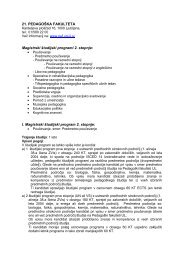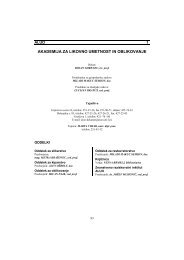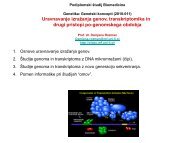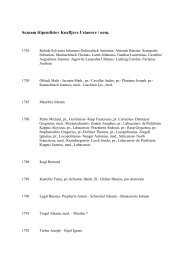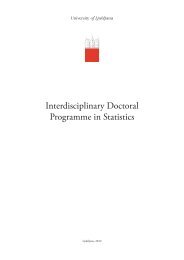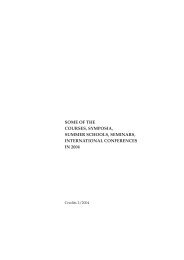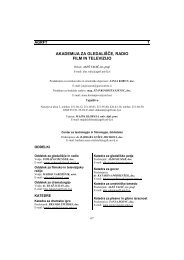Medicinska fakulteta Univerze v Ljubljani 1919–1945 - Univerza v ...
Medicinska fakulteta Univerze v Ljubljani 1919–1945 - Univerza v ...
Medicinska fakulteta Univerze v Ljubljani 1919–1945 - Univerza v ...
Create successful ePaper yourself
Turn your PDF publications into a flip-book with our unique Google optimized e-Paper software.
Second year<br />
a) Physiology<br />
b) General Medicine, Surgical Pathology and Therapy<br />
c) Theory of Obstetrical Delivery<br />
d) Pharmacology and Professional Pharmaceutical Knowledge<br />
d) Science of Prescription Compounding and Dietetics<br />
e) Veterinary Science<br />
Third year<br />
a) Practical Bedside Medical Instruction<br />
b) Special Medical Pathology and Therapy<br />
c) Special Surgical Pathology and Therapy with Instruction on<br />
Instruments and Wound Dressing<br />
d) Surgical Operation Exercises Performed on a Cadaver<br />
e) Forensic Medicine<br />
f ) Exercises in Surgical Operation and Wound Dressing<br />
g) Ophthalmology<br />
After completing the third year, learners had to complete a<br />
practical training period at a surgery ward, which lasted no less<br />
than a month� A month of practical training in obstetrics was<br />
also prescribed, which candidates could not start before passing<br />
the rigorous examination in surgery� The one-month surgical<br />
and internal medicine practical training applied only to those<br />
learners who completed the required learning period with a<br />
barber surgeon; other candidates had to complete a three-month<br />
practical training period, which meant five months including<br />
the training in obstetrics� This shows that two quality types of<br />
Patrons of Surgery were produced by the medical-surgical study<br />
in Ljubljana: graduation candidates with the old apprenticeship<br />
training possessed lower quality expertise than those who<br />
had lower gymnasium education and a total of five months of<br />
practical training�<br />
While theoretical instruction took place in lyceum premises,<br />
practical instruction was provided at the Ljubljana city hospital<br />
where conditions were inadequate even for teaching purposes�<br />
It was only with the establishment of a hospital at the former<br />
discalceate monastery in Ajdovščina (the new hospital in<br />
Ajdovščina), where the so-called clinical school operated, that the<br />
conditions began to gradually improve�<br />
The language of instruction in medical-surgical studies was<br />
initially Latin� During the period of Joseph II and his efforts to<br />
form a unified country with a single language (German), Latin<br />
was also gradually eliminated from medical-surgical studies and<br />
German was introduced, whereby Latin professional terminology<br />
was permitted so as to avoid confusion� Theoretical and Practical<br />
Obstetrics for Midwifes was taught in Slovenian and German in<br />
Ljubljana�<br />
In 1813, the reinstituted Austrian authority was pondering the<br />
abolition of these studies both in Ljubljana and Klagenfurt –<br />
and in doing so, also probably recalling the complete Faculty<br />
100<br />
of Medicine within the scope of the French Écoles centrales and<br />
the increasingly widespread opinion favouring the abolition of<br />
second-class medical-surgical studies at lyceums� Medical-surgical<br />
studies in Ljubljana were most at risk in this respect� The opinion<br />
of Count Saurau, the Court’s Commissioner for Illyria, prevailed<br />
in the end, namely that medical-surgical studies in Ljubljana<br />
should be retained� The Court’s Study Commission expressly<br />
declared on 7 June 1819, “that the school of surgery in Klagenfurt<br />
should remain according to the Emperor’s decree and serve the<br />
Klagenfurt district, while the school in Ljubljana should serve the<br />
Illyrian governorate, which also includes the Villach district”� It<br />
was obligatory for a school to have five professors: an anatomist<br />
(physiologist), an internist, a surgeon, an obstetrician and a<br />
veterinarian� Introduction to the Study of Surgery and Forensic<br />
Medicine had to be taught by two professors who conducted the<br />
course in addition to their other course�<br />
In complete accordance with the new curriculum from 1810 or<br />
1833, teachers of medical-surgical studies in Ljubljana taught the<br />
following courses from 1814 to 1848:<br />
Anatomy and Physiology:<br />
Anton Melzer (1814–1846),<br />
Dr� Kristjan August Voigt (1847–1850),<br />
Surgery:<br />
Dr� Joseph Wattmann (1816–1818),<br />
Franz Fikelscherer (1819–1822),<br />
Dr� Leopold Nathan (1824–1850),<br />
Theoretical and Practical Medicine:<br />
Dr� Anton Jeuniker (1814–1818),<br />
Dr� Ivan Zhuber (1819–1834),<br />
Dr� Franc Schiffer (1837–1850),<br />
Obstetrics:<br />
Jan Matoschek (Matoušek) (1816–1821), MSc in Surgery and<br />
Obstetrics,<br />
Ignac Pintar (1822–1833), MSc in Surgery and Obstetrics,<br />
Dr� Bernard Pachner Freiherr Eggenstorf (1840–1850),<br />
Veterinary Medicine and Forensic Medicine:<br />
Dr� Janez Verbitz (1815–1840),<br />
Dr� Janez Bleiweis (1842–1850),<br />
Introduction to the Study of Surgery, Physics, Chemistry, Botany and<br />
Pharmacy:<br />
Dr� Ivan Biatzowsky (1834–1850)�<br />
In 1815, the hospital in Ajdovščina founded a special ward with<br />
six beds for men and women for the purpose of conducting clinical<br />
instruction� This was basically a plan of Faust Gradišek, member of



